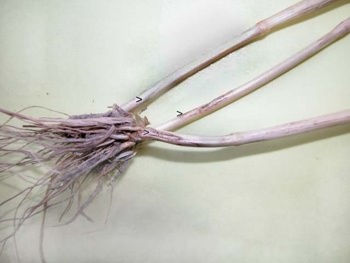Diseases
Pseudocercosporella herpotrichoides (Fron) Deighton - Eye-Spot (Strawbreaker Foot Rot) of Rye.
Systematic position.
Class Deuteromycota, order Hyphomycetales, family Moniliaceae, genus Pseudocercosporella. P. herpotrichoides is placed now at Mitosporic fungi. Teleomorph Mollisia (=Tapesia) yallundae Wallwork et Spooner belongs to class Ascomycota, order Leotiales, family Dermateaceae.Synonyms.
Cercosporella herpotrichoides Fron; Ramulispora herpotrichoides (Fron) Arx.Biological group.
Necrotroph.Morphology and biology.
Pseudocercosporella herpotrichoides infects rye and also species of Triticum, Hordeum, Avenae, Elytriga, Apera, Poa, Alopecurus, Agrostis, Dactylis, Festuca and other Poaceae. The fungus infects plant at or slightly below the soil line and, under favorable conditions; it girdles the stem, resulting in lodging (= strawbreaker). The diagnostic symptom of eyespot is elliptical (eye-shaped) spots on leaf sheaths. Lesions are white to light brown at first, and then turn dark. Later, the stem base is attacked, and gray fungus may grow in the center of the infected area, whose margins are indistinct. The fungus is confined to the basal parts of a plant, rarely developing higher than 15-20 cm above soil level. No symptoms appear on roots. Diseased tillers may mature early, producing white heads. Otherwise, heads are small and fill poorly under moisture stress and high temperatures. Primary infection is caused by conidia or mycelia formed on crop debris. Conidia are spread principally by splashing rain at a distance of 1 to 2 m. The new inoculum appears on developing coleoptile or on basal areas of young culms after 4 to 12 weeks. Conidiophores of pathogen are long, cylindrical, uncolored, slightly thickened towards apex, coming out from stoma in tufts. Conidia (30-105 x 1-3 .m) are solitary or forming small groups, uncolored, having 4 - 8 septae. Unicellular or 2-3-septated sporidia form not infrequently, going out from basal or middle parts of conidia. Microsclerotial bodies abundant, black, 100-500 .m in diameter, giving mycelium or conidia. The fungus overwinters on straw and crop debris.Distribution.
Disease is distributed on all continents where the host-plant is present. In Russia it occurs in all regions of rye cultivation; harmfulness is registered in Northwest region especially.Ecology.
Cool temperatures, wetter soils, and high humidity favor the disease; planting date, winter temperatures, and the amount of disease in the last wheat crop influence the amount of disease in a field. The fungus develops in a wide range of temperatures, from 2 to 30?C. The infection occurs at relative humidity near to 100%. An optimum temperature for mycelium growth is 20 - 23.C. The spores formation is most intensive at 3-15.C. The level of disease development is influenced significantly by fertile soil, terms of sowing, and predecessor.Economic significance.
At strong disease development (50% and more) crop losses may be 30% to 50%. Average long-term losses from Eye-Spot can be estimated as 1-5%. Protective actions: correct crop rotation, duly sowing, fertilizers application, foliar fungicides application (differing from benzimidazole group, to which development of resistant forms is marked), use of resistant (tolerant) varieties.Related references:
Ainsworth G.C. ed. 1971. Ainsworth and Bisby's Dictionary of the fungi. CAB Intern.: 663 p.Braun U. 1995. A monograph of Cercosporella, Ramularia and allied genera (Phytopathogenic Hyphomycetes. IHW-Verlag. v.1. 333 p.
Buga S.F., Ushkevich L. A. 1982. Ethiology and harmfulness of winter rye strawbreaker foot rot in BSSR. Plant protection. Minsk: Urozhai. Issue 7. p. 74 - 78 (in Russian).
Buga S.F., Ushkevich L. A. 1984. Winter rye protection from root rot. Zashchita rastenii. N 4. p. 28 - 29 (in Russian).
Hawksworth D. L., P. M. Kirk et al. ed. 1995. Ainsworth and Bisby's Dictionary of the fungi. CAB Intern.: 616 p.
Ishkova Т. I., Berestetskaja L. I., Gasich E. L. Levitin M. M., Vlasov D.Yu. 2002. Diagnostics of the main fungus diseases of cereal crops. St. Petersburg: VIZR. 76 p. (in Russian).
Levitin M.M. & Tyuterev S.L. 2003. Fungal diseases of cereals crops. Zashchita rastenii i karantin 11: 75 (in Russian).
Tsvetkova N.A., Kostitsyn V.V. 1994. Harmfulness of cercosporella root rot. Zashchita rastenii 3: 47 - 48 (in Russian).
© Dmitriev A. P.


